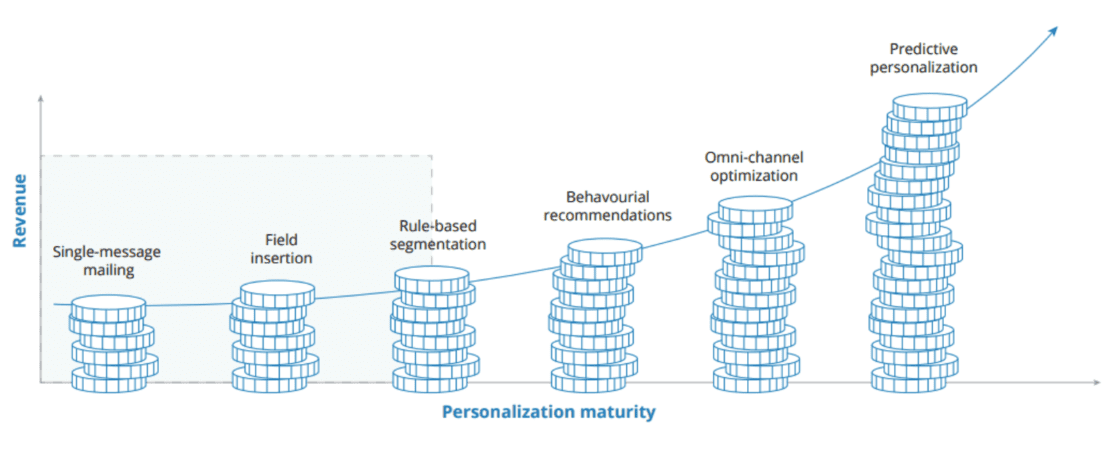In recent years, the banking sector has witnessed a significant transformation in customer experience (CX). The digital age has reshaped customer expectations, driving banks to innovate continually to meet these evolving needs. Today’s customers seek convenience, speed, and personalization, influencing banks to pivot from traditional service models to more customer-centric approaches. The integration of technology in banking has not only streamlined operations but also opened new avenues for enhancing customer engagement and satisfaction.
Hyper-personalization in banking goes beyond the standard practices. It involves leveraging advanced data analytics, artificial intelligence (AI), and machine learning (ML) to provide highly individualized customer experiences. This approach uses real-time data and predictive analytics to understand customer preferences, behaviors, and financial needs, enabling banks to tailor their products, services, and communication at an unprecedentedly granular level.
The Importance of Hyper-Personalization in Retail Banking
Deloitte’s analysis of retail banking highlights the growing imperative for hyper-personalization. The report emphasizes that banks must evolve from product-centric to customer-centric models, a transition that is key to staying competitive in a rapidly changing market. This shift is not just about offering digital services but about using customer data to create more meaningful and personalized banking experiences. According to Deloitte, banks that succeed in this transformation can expect enhanced customer loyalty, higher satisfaction rates, and ultimately, increased revenue.
Traditional banking has been characterized by a one-size-fits-all approach, with standardized products and services. However, the rise of digital technologies has enabled banks to move towards hyper-personalized services. This shift is driven by customer demand for services that cater to their unique financial situations and preferences. Banks are now focusing on understanding individual customer journeys and leveraging data analytics to offer customized solutions that align with specific customer needs.
Real-World Applications and Use Cases in Banking
Hyper-personalization has practical applications that are transforming the banking sector. Here are five key use cases where hyper-personalization is making a significant impact:
a. Customized Product Recommendations: Banks are using customer data to recommend financial products that are specifically suited to individual customer profiles. This approach is akin to the personalized shopping experience offered by leading e-commerce platforms.
b. Dynamic Pricing and Offers: Based on a customer’s transaction history, credit score, and other financial behaviors, banks can offer dynamic pricing on loans, credit cards, and other financial products, along with personalized offers and rewards.
c. Personalized Financial Advice: With hyper-personalization, banks can provide tailored financial advice to customers. This includes investment suggestions, savings plans, and budgeting advice based on the customer’s financial history and goals.
d. Predictive Customer Service: By analyzing past interactions and preferences, banks can anticipate customer needs and proactively address them, leading to a more responsive customer service experience.
e. Fraud Detection and Prevention: Hyper-personalization also plays a crucial role in enhancing security. By understanding typical customer behavior patterns, banks can quickly identify and react to anomalous and potentially fraudulent activities.
Technologies Enabling Hyper-Personalization
The Role of Artificial Intelligence and Machine Learning
Artificial Intelligence (AI) and Machine Learning (ML) are at the heart of hyper-personalization in banking. These technologies enable banks to process vast amounts of data and derive actionable insights about customer preferences and behaviors. AI algorithms can analyze transaction patterns, spending habits, and even social media activity to tailor banking services to individual needs. Moreover, machine learning models improve over time, constantly refining the personalization process as they ingest more data.
Leveraging Big Data for Tailored Banking Services
Big Data plays a pivotal role in enabling hyper-personalized banking services. By analyzing large datasets, banks can gain a comprehensive understanding of their customer base. This analysis includes demographic information, transaction history, online behavior, and even lifestyle choices. With these insights, banks can create highly personalized customer experiences. For instance, Big Data can help identify life events such as buying a home or planning for retirement, allowing banks to offer relevant financial products at the right time.
Real-Time analytics and channel management for Personalized Communications
The capacity to deliver hyper-personalized experiences is heavily reliant on real-time analytics and effective channel management. These components are crucial for interpreting customer data and delivering personalized communications across various touchpoints. Sophisticated tools, like those offered by Latinia, are necessary to harness the power of real-time data, allowing banks to send the right message, at the right time, through the right channel.
Real-time analytics empower banks to make instantaneous decisions based on current customer data. This might include changes in spending behavior, current browsing activity, or the occurrence of significant life events. By analyzing this data as it happens, banks can provide immediate and relevant offers, advice, and solutions that resonate with the individual customer’s current context and needs.
Effective channel management ensures that these personalized interactions occur on the customer’s preferred platforms, whether that’s via an app notification, email, SMS, or even through a personalized web experience. The seamless integration of multi-channel communications is key to engaging customers where they are most active and receptive.
There’s an advanced level of sophistication required for tools that can deliver this caliber of personalization. They must be agile, responsive, and intelligent, equipped with the ability to learn and adapt from each interaction. As such, specialized software solutions are becoming essential for banks that wish to excel in hyper-personalization. These tools are designed to integrate seamlessly with existing banking systems, providing the agility needed to utilize real-time data effectively and enhance customer engagement through targeted communications.
In this competitive landscape, where customer experience can make or break loyalty, the implementation of such advanced technologies is not just an enhancement but a fundamental shift in how banks operate and engage with their customers. As banks strive to personalize their services more deeply, the choice of technology becomes increasingly critical, laying the foundation for a more intuitive and customer-centric banking environment.
Hyper-Personalization Strategies for Banks
Customer-Centric Approaches in Product Design
In the realm of hyper-personalization, a customer-centric approach in product design is paramount. This strategy involves creating banking products and services that are not only responsive to customer needs but also preemptively address future demands. Deloitte’s insights emphasize the importance of banks understanding their customers at an individual level. This deep understanding allows for the design of financial products that resonate with specific customer segments. For instance, a bank might offer a customized credit card with features tailored to frequent travelers or provide a savings account with unique benefits for students. Such personalized products not only meet customer needs more effectively but also enhance the overall customer experience, fostering a sense of value and belonging among clients.
Enhancing Customer Engagement and Loyalty
Hyper-personalization also plays a critical role in enhancing customer engagement and loyalty. Banks that leverage data to understand customer behavior and preferences can create more meaningful interactions. This approach can manifest in personalized communication strategies, where banks reach out to customers with relevant information at the right time, through the right channels, with the help of tools like Latinia. For example, sending a personalized financial management tip via a mobile app notification or offering a customized investment plan via email. This relevance in communication not only increases customer engagement but also builds trust and loyalty, as customers feel understood and valued.

Challenges and Ethical Considerations
Balancing Personalization with Privacy Concerns
While hyper-personalization offers numerous benefits, it also brings challenges, particularly concerning privacy. Customers are increasingly aware of their data privacy rights and are concerned about how their personal information is used. Banks must navigate the fine line between offering personalized services and respecting customer privacy. This balance involves being transparent about data collection and usage practices, obtaining explicit consent, and providing options for customers to control their data.
Addressing Data Security and Regulatory Compliance
Data security and regulatory compliance are other significant challenges in the era of hyper-personalization. As banks collect and analyze more customer data, the risk of data breaches increases. Banks must ensure robust cybersecurity measures to protect customer information. Additionally, they must comply with a complex web of regulations governing data privacy and protection, such as GDPR in Europe and various state-level laws in the US. Navigating these regulatory landscapes requires a proactive approach to compliance and a commitment to ethical data practices.
The Revenue Benefits of Advancing Personalization Maturity
The journey towards hyper-personalization is not just a customer satisfaction endeavor; it has a demonstrable impact on a bank’s revenue. The personalization maturity curve, as illustrated in the graph below, provides a clear trajectory of increasing revenue as banks progress through various stages of personalization maturity.
Starting from basic single-message mailings to more sophisticated predictive personalization, each step forward on the personalization ladder correlates with a tangible increase in revenue. This is evidenced by the substantial sales figures reported by industry leaders that attribute a significant portion of their revenue to hyper-personalized recommendations.
For example, as banks move from generic field insertion in communications to rule-based segmentation, they see an uptick in customer engagement, which translates to higher sales. This progression continues to gain momentum as banks adopt behavioral recommendations and omni-channel optimization, culminating in the sophisticated approach of predictive personalization. At this stage, banks are not just reacting to customer behaviors but anticipating their needs, leading to a proactive service delivery that customers are willing to pay for.
The case of hyper-personalization’s efficacy is made even stronger by the success stories of non-banking corporations like Amazon and Netflix, which have harnessed hyper-personalization to secure 35% and 60% of their sales, respectively. Similarly, Starbucks has witnessed its incremental revenue triple through the strategic use of hyper-personalized offers.

Source: The future of retail banking – The hyper-personalization imperative – Deloitte
Conclusion
The journey through the personalization maturity curve reveals that hyper-personalization is a robust strategic initiative with measurable impacts. It has proven its worth by enhancing customer experiences, deepening client relationships, and significantly increasing revenue for those who have implemented it effectively. The advancements in technology, particularly in AI and Big Data, have empowered banks to not just understand but also predict customer needs, delivering not just services but tailored experiences that resonate on a personal level.
For banks, the imperative is clear: to remain competitive and profitable in a rapidly evolving industry, adopting hyper-personalization is no longer optional—it is vital. Banks must embark on this transformative journey, leveraging the wealth of customer data at their disposal to deliver personalized banking experiences. Companies like Latinia play a crucial role in this transformation, offering the tools and expertise needed to implement effective hyper-personalization strategies.
In the end, the hyper-personalization of banking services aligns with the ultimate goal of the financial industry—to serve the customer in the most efficient, secure, and personalized manner possible. The statistics and trends outlined in this discussion, along with the capabilities of companies specializing in this field, make a compelling case for banks to not only adopt but excel in hyper-personalization, ensuring their continued growth and success in the future of banking.
To explore hyper-personalization possibilities in your bank, book a free consultation here.
Categories: Customer Experience

